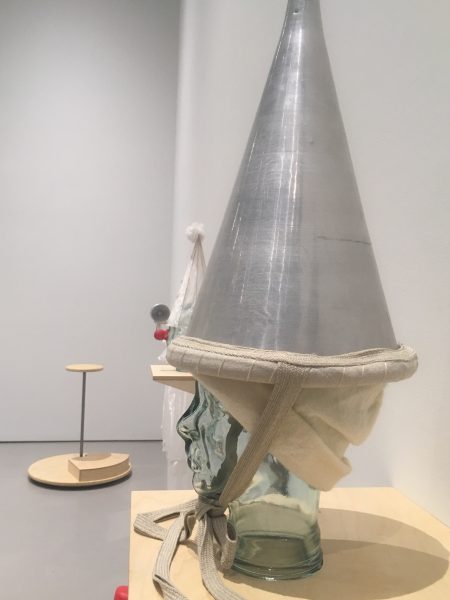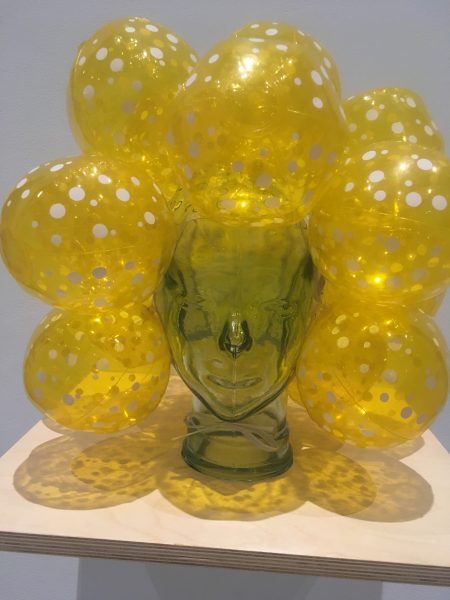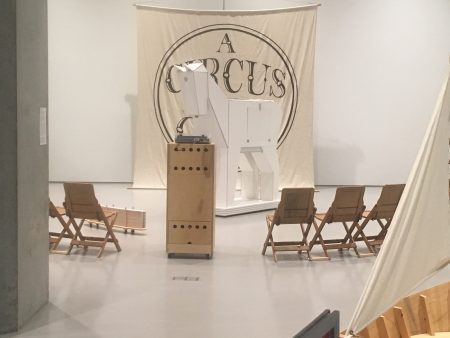Alison Crocetta, Associate Professor at The Ohio State University, spans sculpture, performance, and video art in her work. The Contemporary Arts Center’s exhibition “Circus of One,” features Crocetta’s video art pieces and performances, often presented in digital photography form, divorced from their performative semblance. Her solo-screening at the CAC, “A Circus of One” features the eponymous signature 16 mm black-and-white film, replete with composer Jason Treuting’s soundscapes, alongside sculptures, photographs and collective vessels. Otherwise, works like 100 Touches/100 Breathes and Shed are shown as still images, part of larger endurance-based performances. This begs the question whether, when full-length presentations such as Chris Larson’s are exhibited, whether Crocetta’s “snapshot”-esque duplicates are replete with the same prowess. Furthermore, Crocetta’s work achieves aesthetic constructive ends absorbed with self-purpose –pieces that function as “memories of construction,” recovered recollections, and histories divorced from situational and socio-political imperative.
As an aleatory postmodern composer, Treuting’s soundscapes translate numbers and letters into sound patterns. The film A Circus of One (2011) records the artist donned as a “clownish figure” inside of a one-ring circus composition, as she completes eight acts that run the gamut from feats of daring to absurd gestures. “Circus of One” highlights the theatrics of the circus while veiling it with mystique, divesting into pageantry and the spectacle. Paired with Treuting’s found-sound and self-composing “musique concrete”, Crocetta’s exhibition is complete with garments and headwear that Crocetta built as props alongside curious installations that create a reflexively and forced “balanced show.” In doing so, Columbus-based artist Alison Crocetta not only orchestrates promenades of endurance-based performances, short films, photographs, and built material environments that circulate around herself (and self, solely) but also conceptualizes cultural histories that fall short. Without the full performances in documented form, these histories are devoid of their vigor and historical importance. Crocetta synthesizes archival pedagogical and philosophical notions, situating glimpses of episodes and punctuating the notion of an open-ended carnival amongst collective debris. Rather than simply create the fantasy conditions for self-conscious seeing, Crocetta renders simplified clown costumes into single-ring stages. Despite her study of clown history, Crocetta’s subjectivity falls short to a personalized fantasy with endurance and self-absorbed free play.
As Montague Summers elucidates in her book “The Galanty Show: An Autobiography by Montague Summers” the “galanty show” is a historic shadow-puppet show popularized in the Ottoman Empire and the Muslim world, where miniature figures glide and bounce across screens and walls. The whimsical Turkish shadow puppets “Karagoz and Hacivat” exist as contemporary versions of “The Galanty Show.” Nonetheless, Crocetta’s single-channel video installation The Galanty Show (2009) displays black-and-white silhouettes cast upon a wall complete with ballerinas, hula-hooping rabbits, pirates, clowns, and other hybrid events along a single axis, where the performance objects and garments dramatize performers. Juggling clowns and rubber-nosed translucent figures trample through the screen with exaggerated shoes. This serves as an example of Crocetta’s subjective desire and aesthetic obsession trumping socio-historical consideration(s).
While Crocetta’s historical ventures could perform a dual operation of authentication and obfuscation by tracing material and intrinsic traces of authorship, it fails to do so by taking solitary case-examples, as in 100 Touches/100 Breaths (2012). Here, silver gelatin prints were part of the exhibition in which Crocetta utilized “hanji paper” – a traditional Korean form of paper produced from the pulp of mulberry trees. However, this context is unimportant to the surface-value production; 100 touches/100 Breaths heavily refers to the subjectivity in production, as the paper-maker is required to touch the material numerous times to make the single sheet. Hanji paper can also naturally filter air due to its thin and viscous materiality or be used to wrap corpses. Crocetta’s isolated survey of materiality implores readings that cull Korean domestic architecture alongside the centerfold of the American spectacle to reach towards much more philosophically sophisticated ends – that of an archivist unearthing how linear history is carved and imagistically represented. The presentation of Crocetta’s work, however, does not achieve these ends.
Hence, Crocetta attempts to apply the methods and results of “effective history” to the history of art spaces as a means of rendering aesthetic origins and preoccupations devoid. However, her very work, relies on objects of historical periodization, belying Crocetta’s mission of balance and organization ushered in periodization and subjectivity.
Crocetta offers work that studies the influence of memory and addresses the notion of collection as an occluding or obscuring act, as Crocetta transforms space. Unfortunately, it is not that transformation with which audience members are presented. Clear/Fill/Reveal (2003) features a Super 8mm black-and-white film trilogy that records performances of the meta-union of artist, object, and media into architecture. The three works record Crocetta’s performances in a structure she deems a “headspace,” fit for her head and hands. Fill celebrates Crocetta’s creation of sculptural forms that transform space, as she constructs a grid from household string as a formal and conceptual technical assemblage. The consequent barrier is juxtaposed with Clear, which features a sound track of Crocetta uttering a mantra of “see no evil, hear no evil, speak no evil and think no evil” in urgent succession. Conclusively, Reveal revels in self-obsession, as Crocetta contemplates the search for love, again using a popularized manta – “she loves me, she loves me not” as she plucks flowers off of her top-hat. The barren result of the three-part piece results in built performances and interactions that create mythical, banal aesthetic elements that fashioned intimacy within a shared, disjointed ecology.
Crocetta collected her own breath in 100 hanji boxes, which swell into cubes that serve as effigies in the room where she displays sculptural vessels. This piece, titled 100 Touches/100 Breathes (2012) was part of an exhibition where Crocetta focused on the use of breath as a recurring theme, performing a piece that would realize the ephemera of form and transience in life.
Crocetta’s highly personal performances are submitted as aptly simplistic works presented to general view, which may itself be of artistic, critical, and philosophical importance. Crocetta bisects crucial junctures in the histories that she involves herself with, junctures during which the act of viewing or judging her works and art-artifacts become matters of explicit concern, that is, in some way problematic, for artists, critics, or philosophers who employ an ethnographic agenda. Korean hanji paper, in addition to naturally filtering impurities in air, is also employed to sheathe corpses before burial and used as tapestry and lining in Korean interior design. However, Crocetta has personalized the cultural motif in her performance without imperializing the history through commodity.
Hence, Crocetta’s surveys of objects and materiality undo any socio-geographical intent, rooting themselves solely within artist subjectivity and destabalizing any unified history of pictorial “exhibition value” (Benjamin). Such is the case in SURRENDER (New York) (2014), which was a three-hour performance captured in digital photographs. Nodding at the playfulness of the circus-spectacle, Crocetta’s New York performance event contemplates the notion of surrender, drifting from American spiritual songs to archiving the time-based action of surrender-ship. In SURRENDER (New York), Crocetta worked with charcoal-media artist and New School Professor Charlotte Schulz to “draw” the action of surrender as a means of recognizing the history of war in United States history. Schulz’s accompanying drawings are paired with Crocetta’s performance of raising a white flag and audio of This Little Light of Mine and We Shall Overcome. The outcome is that metaphorically manifest that Pete Seeger’s We Shall Overcome is the mirror with which Crocetta seeks to revisit U.S. Trauma. Although the song became transcribed as I’ll Overcome Some Day, a hymn by Rev. Charles Albert Tindley (published in 1900 as a protest song and a key anthem of the Civil Rights Movement) as a researcher Crocetta misidentifies and outright conflates protest and self-absorption.
Photographic images like Shed (2006) are solely documented performances. Shed was a performance where Crocetta’s body was weighed down with water filled balloons that produced a maximum load that the artist couldn’t physically bear. During the first portion of the Super 8mm trilogy Gather/Shed/Lift, scored by composer Barbara White, Crocetta locates a city rooftop and a farmer’s field to empty a diving pool as her performantive action. Every rendering records the process of movement, collection, and release in open narrative, but the two-image Shed (2006) only displays Crocetta thwarted in a vessel of water balloons and the subsequent remnants. After they had been systematically cut off her heaving body, unburdening the off-camera Crocetta, Shed’s second image ambiguously laments ominous bulbous forms that leak tangled tracks across the ground – even in this second image, Crocetta’s body frames the invisible design. The images are hollow and gray, and framed by absent performance, performances that flirts with the dated and more assumed self-endurance undertakings of artists such as Abramovic and Flanagan.
It is unfortunate that so many of Crocetta’s performances are realized solely as photographic renderings, for the pieces are certainly temporal and dynamic (which is understood even under still observation). Crocetta willfully denies conflict and prompts erasure by performing cross-disciplinary allegories that self-align and archive virtual fantasy, free-play politics, and odious prereogative. The manifold of vestments, vessels, moving images, central sculptural assembly, still photographs and projections creates the appeal of a “well-balanced exhibition”. However, Crocetta’s disjointed work fails to demonstrate a historical chain of connections between the time and place of production, harking creating ghostly valves that echo the hollow clown-garb that hugs the exhibition walls. Furthermore, Crocetta’s clown references lack any reference to the stock characters of Commedia Dell’arte, disjointed once again. Although Crocetta “attended a clown school to learn to walk on the stilts used in one of her performances” (Watson), she now obfuscates self-ritual with cultural referents that go untied. Her contemporary work, compared to “Moving Images” at the Weston Gallery in August of 2011 has matured as it flirts with post-structuralist deconstructivism’s penchant for the archival museum, but both her films-presented-as-stills and stock referents are isolating when compared to full-fledged absorption in Chris Larson’s contemporaneous exhibition at the CAC.
–Ekin Erkan
Works Cited
“Alison Crocetta.” Department of Art, 11 Dec. 2017, art.osu.edu/people/crocetta.1.
Batkin, Norton. “Conceptualizing the History of the Contemporary Museum.” Philosophical Topics, vol. 25, no. 1, 1997, pp. 1–10., doi:10.5840/philtopics199725122.
Buskirk, Martha. The Contingent Object of Contemporary Art. MIT, 2005.
Morriss, Matt. “Moving Pictures.” CityBeat Cincinnati, 29 June 2011, www.citybeat.com/arts-culture/visual-arts/article/13011549/moving-pictures.
Watson, Fran. “Ode to Trendiness.” AEQAI, AEQAI, 25 June 2011, aeqai.org/2011/07/ode-to-trendiness/.




